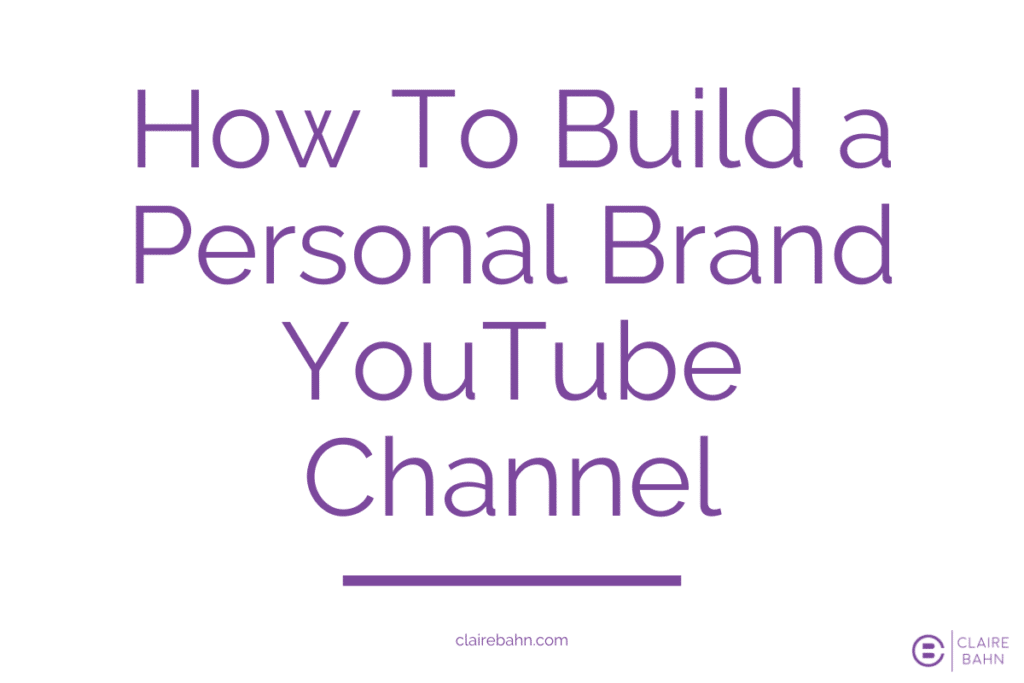I started a brand YouTube channel in 2015 called Gluten-Free Avenger.
This was before gluten became mainstream, but it was also around the time that Marvel’s Avengers films were at their peak. So I was preemptively setting myself up for success.
Or so I thought.
I was in on a trend before it was “cool,” and I had chosen a name that had the ability to go extremely viral— even if it was to talk about how to make the best Banana Buckwheat Pancakes you’ve ever had.
In effect, I had done everything right. I reviewed products, I interviewed other gluten-free “avengers,” and I uploaded pretty consistently for a while.
Unfortunately, my YouTube stardom never came to be. And while I’m glad for that now, I know that there are even greater opportunities on YouTube for people who want to thrive as an industry leader or influencer.
Why am I glad that this channel never took off? For the same reason, many YouTubers and influencers regret their claim to fame.
It wasn’t my personal brand.
RELATED: 5 STEPS TO DEVELOPING A PERSONAL BRAND FOR BEGINNERS
How To Build a Personal Brand YouTube Channel
The names you hear the most about regarding successful YouTubers are the ones with an actual name: Casey Neistat, Liza Koshy, and Lily Singh, to name a few.
And where are these acclaimed YouTubers now? Liza Koshy is an Emmy Award nominee, TV host, and appeared in Forbes 30 Under 30 Hollywood & Entertainment list and the Time 2019 list of the 25 Most Influential People on the Internet. Casey Neistat has a reported net worth of $16 million after selling his video-sharing app called Beme to CNN. Lily Singh (who recently rebranded after nearly a decade of being known as “Superwoman”) became the first-ever female late-night talk show host for NBC.
In 2015, personal brands weren’t recognized by YouTube by the proper definition. But it’s precisely what YouTube banked on to earn them (and their creators) millions and billions of dollars.
YouTuber, Creator, Influencer, Thought Leader— it doesn’t matter what you call it because they’re all the same thing: a personal brand.
Building a Name for Yourself
When you choose to brand your YouTube channel as yourself instead of something gimmicky like The Gluten-Free Avengers, you have the chance to explore what topics you have a passion for and where you can stand out in a particular niche.
This is why influencers like Lily Singh choose to rebrand to a name/personal brand: to not only form a more intimate connection with their audience (they’re on a first-name basis now), but to open doorways for opportunities without the confusion of branding products, TV shows, or apps under their original pen name.
It took me a couple of tries to figure out my path, but having a personal brand has saved me time and energy from having to rebrand over and over again.
After helping numerous thought leaders and CEOs solidify their personal brand for growth, I think that it’s about time that I give you a glimpse at what I teach my clients. Below are the 5 steps I walk my clients through to build a brand YouTube channel that can boost their careers.
YouTuber, Creator, Influencer, Thought Leader— it doesn’t matter what you call it because they’re all the same thing: a personal brand.
1. Set Up Your Personal Brand YouTube Account
Setting up a brand YouTube channel is relatively easy. However, if you’re new to this platform, I have a step-by-step guide on a beginners’ YouTube channel setup.
As tedious as it may seem, each step in this process plays a critical role in your brand awareness. Everything from your profile picture to the tags you use helps secure audience retention and grow your subscriber base.
A part of setting up your brand YouTube account (the right way) is figuring out your image. Color psychology is a real thing, which means that your color pattern should remain consistent across your thumbnails, your banner image, and even the colors you use in your videos.
93% of buyers focus on brand color when purchasing a product, so if you choose a color like pink, you’re probably going to appeal more towards the female demographic. If your target audience is male and you use colors like orange, yellow, or brown, you’re going to have a hard time retaining their attention since studies show these are three colors that appeal to men the least. If you’re looking to appeal to both men and women, using the color blue across your YouTube channel will be your safest bet.
But before you even begin the physical branding of your channel, we need to make sure you know what type of videos you’ll be creating. In order to do that, we need to do some research and brainstorming.
RELATED: THE FIRST 5 THINGS YOU SHOULD DO WHEN BUILDING YOUR BRAND
2. Figure Out Your Niche Topics
The key to coming up with endless video ideas to start by identifying a problem you want to solve. Don’t try to appeal to everyone. Figure out who your ideal client is and a handful of problems they struggle with daily.
For me, my ideal client struggles with maintaining brand consistency, knowing how to boost their brand recognition, and content creation.
From those topics, I can branch out into more niche and specific content ideas such as 5 Ways To Boost Productivity, 10 Self-Care Tips For Entrepreneurs, and Do You Really Need a Blog for Business Marketing?
I’ve successfully defined my core topics and was subsequently able to break down each one to solve a very specific problem that my target audience is having.
SEO Keywords
It’s not enough to know what topics you’re going to talk about, even if they are pretty specific. YouTube is a search engine just like Google, which means you need to know how SEO works.
SEO keywords are words that people type into the YouTube search bar to find answers to their problems. So if I wanted to show up under search results for someone who types in “How To Build a Personal Brand YouTube Channel,” I need to make sure those keywords (specifically “brand YouTube channel”) appear in my title, description, tags, and my YouTube thumbnail.
You may be wondering how I know that people are searching for those topics on YouTube. That all ties into SEO research, which I do for my clients before pitching them YouTube video topics.
You can use resources like Ubersuggest and SEMrush to type in niche topics you want to create videos around and see what comes up. If the results show that zero (0!) people type these keywords in search bars, you might want to rethink how you phrase the keywords (or look for a different topic entirely).
RELATED: HOW TO CREATE YOUR OWN BUSINESS IN 10 STEPS
3. Research Your Competition
The last thing you want to do is spend hours on end creating YouTube content to find out there are already 50 videos on the same topic. With that much competition, your brand YouTube channel is going to be a needle in a haystack that your target audience will never find.
As I start writing down video ideas for myself (or my clients), I’ll do some keyword research on my own to see what’s already out there. If I type in “How To Build a Personal Brand YouTube Channel” on YouTube, here’s what shows up:

There are only two videos that show up that I would consider my competition: the top two. The rest of the videos that show up under this search are videos about setting up a brand YouTube account, which is a different topic altogether.
The first two were both made in the last year, with Sunny’s video being the most recent (March 2020). Sunny and Erin on Demand both have pretty significant views (100K-300K+), but the numbers are not outrageously high to make me think that I can’t earn a spot in the top search results. All you really need to do is your SEO research and share your video routinely on social media.
You should be doing this before you hit the record button. If the results showed me that there were already ten videos made within the last year on my chosen topic, and each video had over a million views, I would not have created a video on it. Instead, I would have found a more niche video idea that had the chance of being seen by more of my target audience.
Take It a Step Further
If you want to take it a step further, you can click on the YouTube video results that pop up and watch them. For instance, I watched Sunny and Erin’s videos before writing this blog. I wanted to make sure that this blog (and video) hit key points that their videos don’t cover.
And if I really want to dive into my competitor research, I would go to each of their brand YouTube channels and make a note of what type of videos they’ve already created. This will help me figure out what our shared audience might be interested in, and it prevents me from replicating the same content as someone in my industry.
RELATED: HOW STARTUP FOUNDERS CAN STEP UP THEIR PERSONAL BRANDING IN 5 STEPS
4. YouTube Favors Consistency
We see it all the time: strange (and seemingly pointless) YouTube channels with millions of followers. And we have to ask ourselves,
“How did they do that? How did someone create a million-dollar company by posting videos of them living daily lives?”
The answer is consistency.
When I started my first YouTube channel, I was consistent. I posted every single week beginning in February 2015. But I stopped being consistent in less than a year.
So what happened? As entrepreneurs, we tend to be creative thinkers. This usually means that we have numerous interests, and they tend to change frequently over time. When they do change, we become inconsistent, and that puts a bad mark on your brand.
This is exactly what happened to me. Over the last 15 years, my brand YouTube channel went from being a gluten-free cooking channel to a fashion lifestyle channel (Living with Claire) and finally to Claire Bahn.
If I could give any advice to 2015 Claire, I would tell her just to keep showing up. And to switch to a personal brand because then maybe my YouTube channel would have taken off back in 2015. With a personal brand, people invest their time in me as a person, so I could easily pivot my channel to align with my interests without losing subscribers.
And while some brand YouTube channels have taken off in the span of a couple of months, it is not the majority, and it should not be your expectation. Consistency is the only ingredient in the YouTube algorithm that will lead to a dedicated fan base that is willing to buy products and services from a video content creator.
You Can’t Depend On Viral Videos
A lot of people decide to start creating YouTube videos based on the appeal of becoming well-known and monetarily successful.
This is Mistake #1.
We can all understand the thrill of going viral and becoming an influencer, but it shouldn’t be the end all-be all of having a YouTube channel.
Simply showing up in video content is enough to bring you a wealth of opportunities; be it new clients, new customers, investors, or press coverage. You don’t need YouTube fame for these things to take place— you need to be consistent with your video content.
RELATED: 10 YOUTUBE TIPS FOR PERSONAL BRANDS
5. Collaborations with YouTubers
Earlier I mentioned researching and watching my competitors’ video content to see what I’m up against.
If you want your personal brand YouTube channel to thrive, one of the best-proven methods is to collaborate with other video content creators.
I noticed this tactic when I first created my YouTube channel. That’s why I went out of my way to interview other people for my channel. However, I made the mistake of depending on the interviewees for my content instead of finding other content creators to work with to develop a video campaign idea together.
So in my case now, reaching out to someone like Erin or Sunny to do a video collaboration would be a significant step in the right direction. Instead of looking at someone like Sunny as my competitor, I’m looking at her as a collaborator. The goal of collaborating is to create videos that will help both of our audiences.
However, it is standard practice to first collaborate with video creators who have roughly the same subscriber count as you. People like Sunny, who have nearly half a million subscribers, have to ask themselves, “What’s in it for me?”
On my end, the collaboration would expose me to a new audience. While it’s not impossible for this collaboration to happen, I would need to pitch her the idea of working together with an incentive to make her time working with me worthwhile.
Introducing her to investors or journalists in my sphere of influence, or an exchange of services are all great options to work with. Remember, there’s no harm if you want to go big and pitch to well-known thought leaders or brands in your industry.
The worst they can say is no.
RELATED: 4 REASONS YOU NEED VIDEO CONTENT MARKETING FOR YOUR PERSONAL BRAND
Conclusion
Over the last decade as I’ve built up numerous businesses like Online Profile Pros and my own personal brand, Claire Bahn. And do you want to know which one has brought in the most press features, investors, and the most overall ROI?
I’ll let you guess.
There’s a lot of work that goes into your personal brand, the most intimidating of which includes creating video content. That’s why I decided to include this in my Personal Brand Concierge Service.



